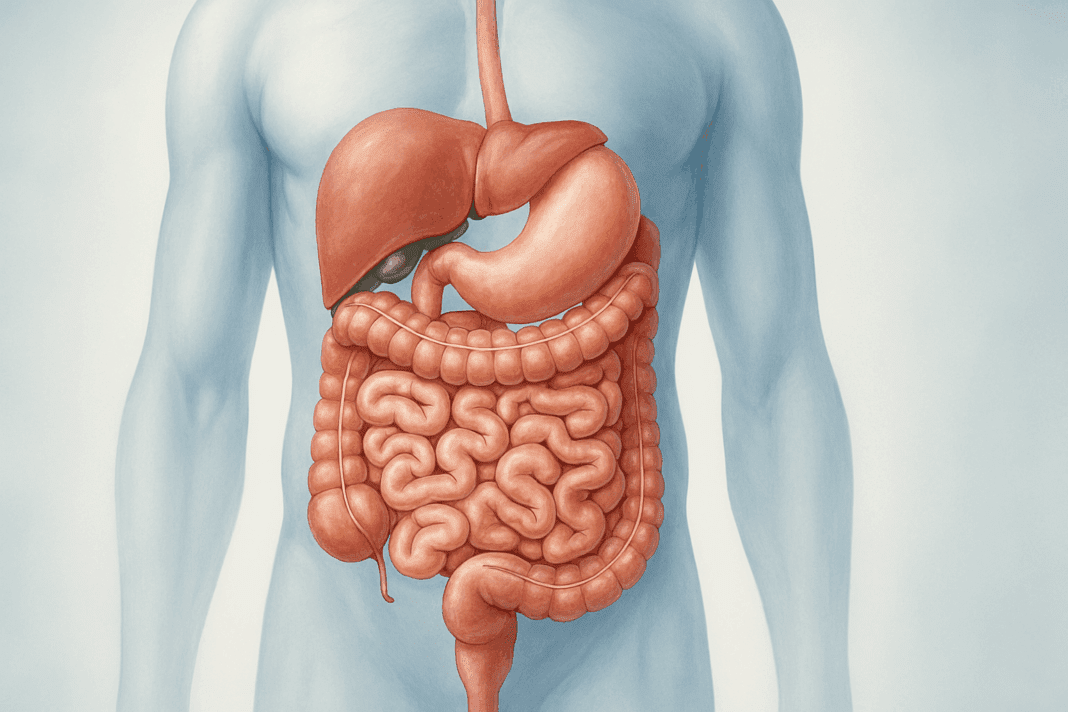The digestive system is a marvel of coordinated biological engineering, designed to transform the food we eat into nutrients our bodies can use. Central to this intricate process are the intestines, which are not only vital for digestion but also for immune function, nutrient absorption, and waste elimination. Yet, despite their essential roles, many people remain uncertain about where the intestines are located, what they actually do, and how their complex anatomy supports everyday health. To demystify the subject, we must explore the intestines anatomy in full, diving into the exact placement, structure, and function of both the small and large intestine. Along the way, we’ll answer common questions like where is your small intestine, where is your bowel, and where is feces stored.
You may also like: Macronutrients vs Micronutrients: What the Simple Definition of Macronutrients Reveals About Your Diet and Health
While the intestines are typically referred to in general terms, the reality is that the intestine system consists of multiple highly specialized segments, each uniquely designed to perform distinct tasks. These components are often misunderstood or oversimplified, but an accurate understanding of the large and small bowel, including the various bowel parts, offers insights not only into digestion but into broader aspects of human health. This includes everything from how nutrients are absorbed to where is poop stored and where does poop come from. In this in-depth guide, we’ll explore each part of the intestinal tract, how it functions in coordination with the rest of the digestive system, and how its precise location within the body contributes to its role in overall wellness.
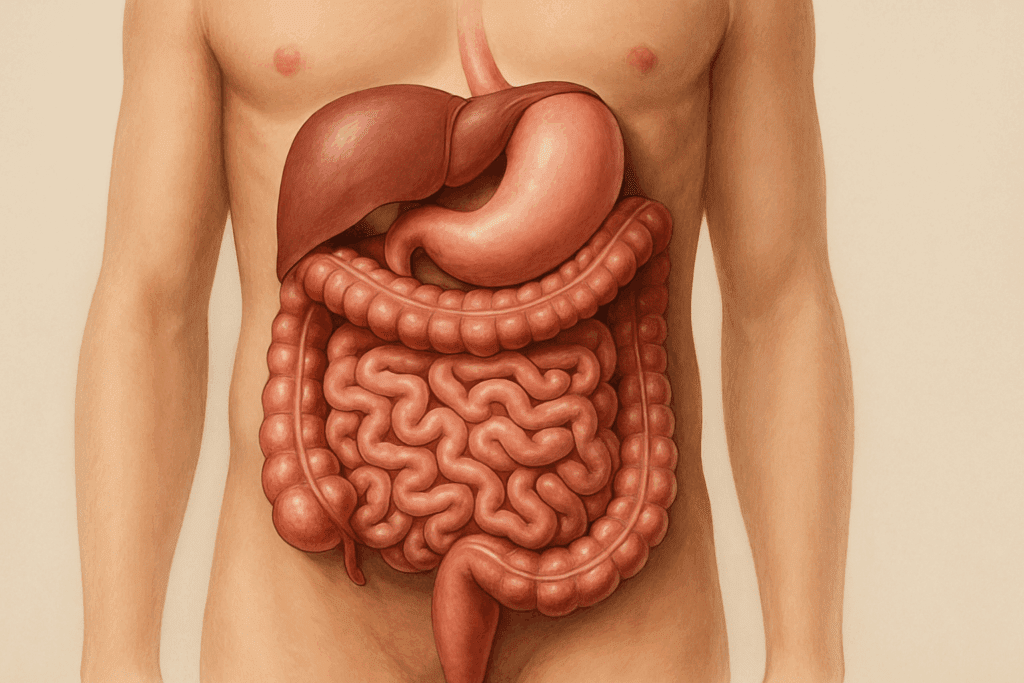
Understanding the Anatomy of the Intestines
When considering where are the intestines located, it’s essential to first recognize that the human intestinal tract is a continuous tube running from the stomach to the anus. It winds through the abdominal cavity in a tightly packed and carefully organized fashion. The intestines are broadly divided into two main sections: the small intestine and the large intestine. Each of these is further subdivided into anatomically and functionally distinct parts. The small intestine, for instance, consists of the duodenum, jejunum, and ileum, while the large intestine includes the cecum, colon, rectum, and anal canal. Knowing these distinctions helps explain both the unique and overlapping responsibilities these structures share.
As a whole, the intestines occupy the central and lower abdominal cavity. The small intestine, which is around 20 feet in length, is coiled loosely in the center of the abdomen. This structure lies just below the stomach and is framed by the larger, thicker large intestine, which is approximately five feet long and surrounds the small intestine in an inverted U-shape. For those wondering where is your large intestine or where is your bowel, the answer lies along the outer perimeter of the abdomen, running from the lower right side (beginning with the cecum) up to the upper right (ascending colon), across the top (transverse colon), down the left side (descending colon), and ending in the rectum.
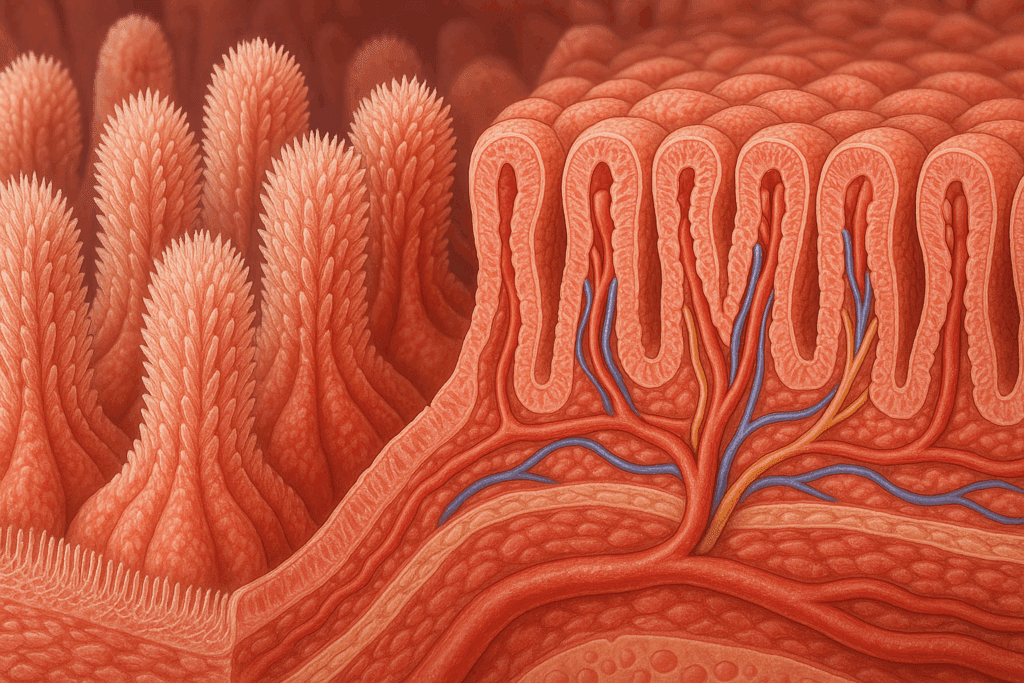
The Parts of the Small Intestine: A Closer Look
Delving into the parts of the small intestine, we find a finely tuned sequence of structures that collaborate to digest and absorb the vast majority of nutrients. The duodenum, the shortest segment, is the first portion that receives partially digested food from the stomach. It plays a pivotal role in chemical digestion by mixing the chyme with bile from the liver and enzymes from the pancreas. Next is the jejunum, which has a rich blood supply and a highly folded lining that allows for maximum absorption of nutrients such as carbohydrates, proteins, and vitamins. The final portion, the ileum, continues nutrient absorption and is especially crucial for absorbing vitamin B12 and bile salts.
Because of its length and surface area, the small intestine is the primary site where digestion actually happens. People often ask what happens in the small intestine, and the answer is deceptively complex. It’s not just about breaking down food; the small intestine also houses a significant portion of the gut’s immune defenses. Specialized cells in its lining monitor for pathogens, while the microbiome assists in digesting fibers and synthesizing essential compounds. Understanding the small intestine vs large intestine is essential for appreciating why nutrient absorption occurs almost exclusively in the former.
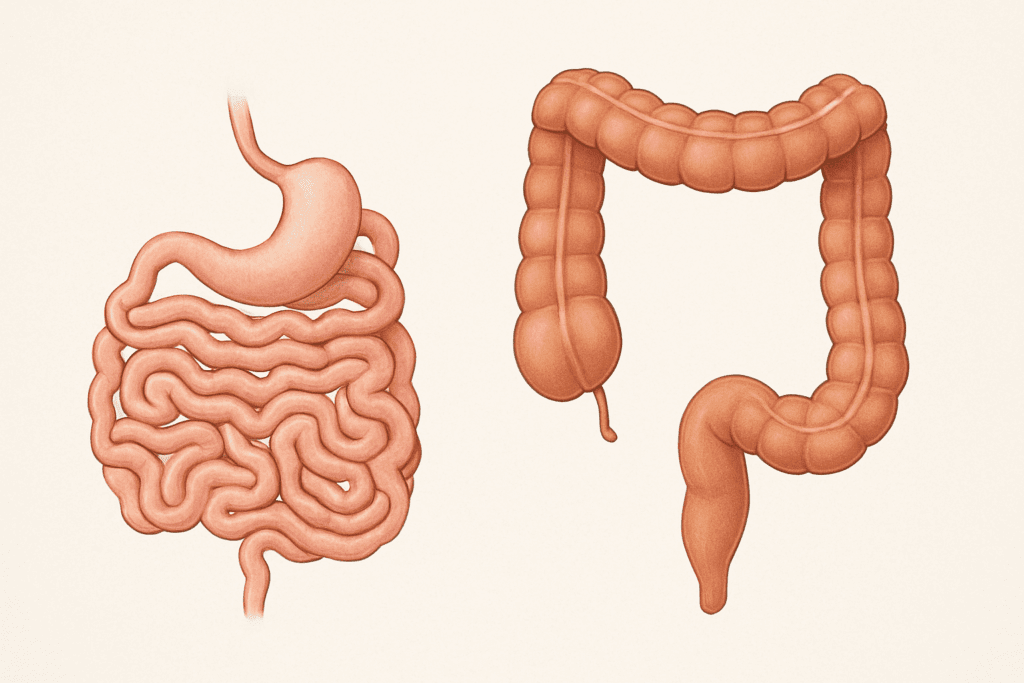
Comparing the Small vs Large Intestine
The differences between the small and large intestine are not only anatomical but also functional. In a comparison of the small intestine vs large intestine, it becomes clear that each segment serves a distinct purpose within the broader digestive process. The small intestine’s main job is nutrient digestion and absorption. It has a long, narrow, and intricately folded structure lined with villi and microvilli that massively increase surface area. These features are essential for absorbing the broken-down components of food, such as amino acids, glucose, and fatty acids.
In contrast, the large intestine is shorter and wider, with a structure suited to extracting water and electrolytes from the indigestible remnants of food. The large intestine parts include the cecum, ascending colon, transverse colon, descending colon, sigmoid colon, and rectum. The large intestine function in digestive system activity is largely centered on converting liquid waste into solid stool, absorbing remaining nutrients, and housing beneficial gut bacteria that ferment fibers into short-chain fatty acids. This is also where feces are formed and where is poop stored prior to excretion. Thus, while the big intestine and small intestine work in harmony, they focus on very different aspects of digestion.
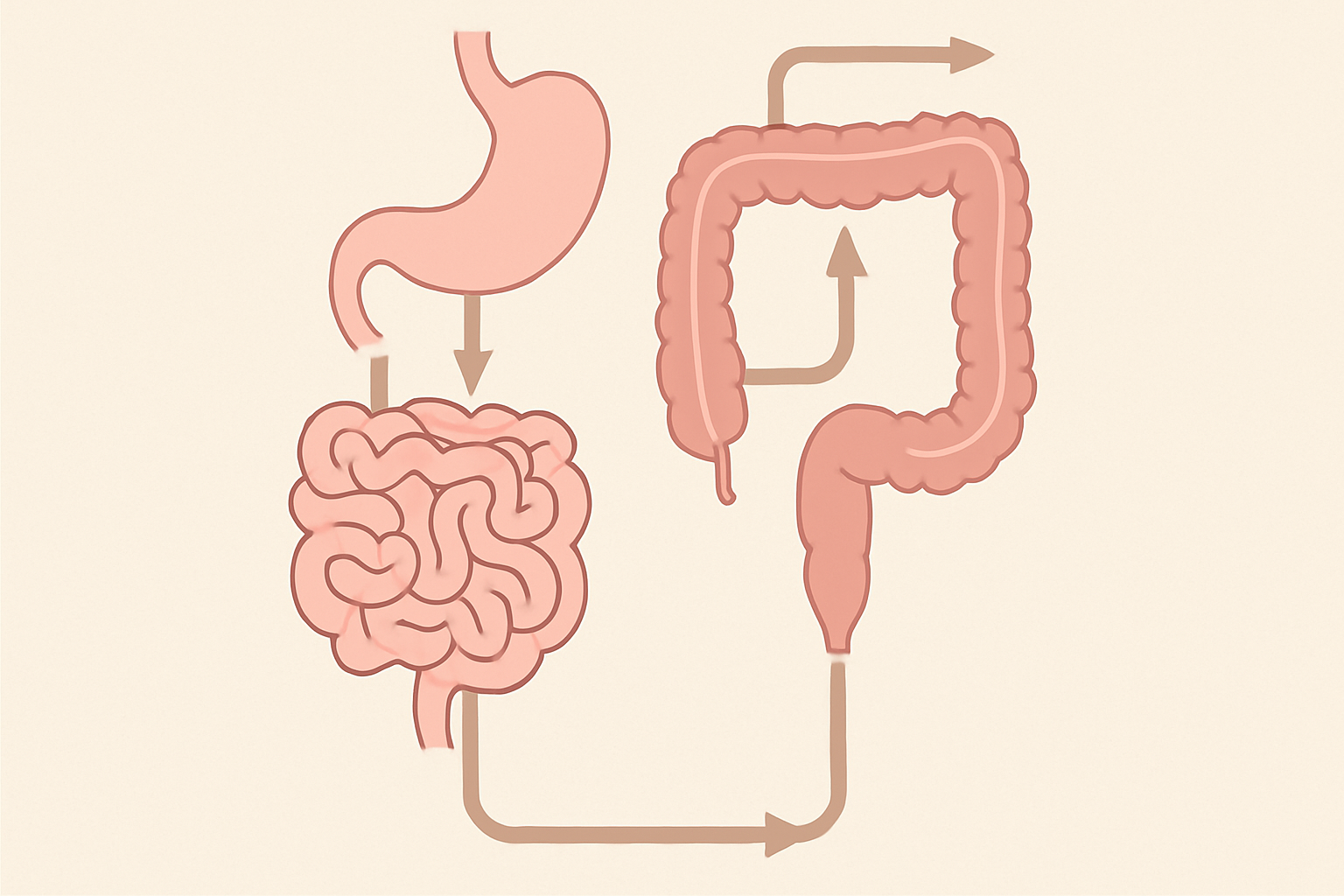
The Journey Through the Intestine System Diagram
Visualizing the flow of food through an intestine system diagram helps clarify how digestion progresses from start to finish. After leaving the stomach, food enters the duodenum, where it mixes with bile and enzymes. It then travels through the jejunum and ileum, where absorption intensifies. This progression reflects the organized structure of the small and big intestine and highlights the importance of proper intestinal function for nutrient assimilation. Once the remaining waste exits the ileum, it enters the cecum of the large intestine, beginning a new phase focused on moisture absorption and feces formation.
Each of the large intestine parts contributes something essential. The ascending colon absorbs fluids and salts, the transverse colon continues water absorption and begins forming solid waste, and the descending and sigmoid colon store feces until defecation is triggered. Knowing where is faeces stored—within the rectum at the end of the large intestine—answers a question that often goes unasked but holds significance for understanding bowel habits and disorders like constipation. In short, the intestine intestine structure is designed with strategic precision, ensuring that waste is processed efficiently while nutrients are spared and utilized.
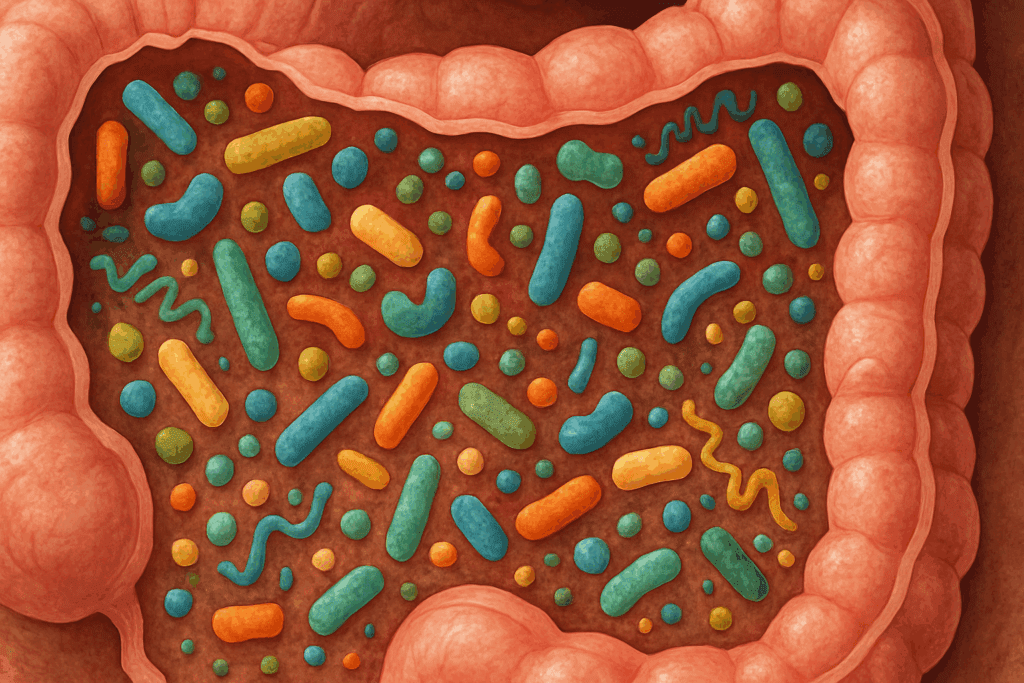
The Large Gut and the Microbiome
Often referred to colloquially as the large gut, the large intestine is a hub of microbial activity. Trillions of bacteria live in the colon, forming a complex ecosystem known as the gut microbiome. These microbes play a role in everything from immune system modulation to mood regulation through the gut-brain axis. While they are mostly located in the large bowel and small bowel, their concentration is highest in the colon. This is because the environment in the colon is slower-moving and more anaerobic, which supports the growth of a wide range of bacterial species.
This microbial ecosystem is one reason why the intestines anatomy is so critical to health. A diverse and balanced microbiome supports digestion, protects against pathogens, and synthesizes certain vitamins. Conversely, disruptions to this balance can lead to bloating, diarrhea, irritable bowel syndrome (IBS), and even systemic inflammation. Maintaining a healthy large gut through diet, hydration, and possibly probiotics is a key aspect of digestive wellness. This also highlights why understanding where are your intestines and how they function can empower people to make better health decisions.
Clarifying Where the Intestines Are Located
For those still wondering where are your intestines or where are your intestines located, the clearest answer is that they occupy most of the space in your abdominal cavity. The small intestine lies centrally and loosely, coiling through the midsection of the abdomen. It is framed by the large intestine, which starts in the lower right quadrant of the abdomen and loops upward, across, and downward before finishing at the rectum. Understanding this spatial arrangement helps explain how abdominal pain in different locations can signal issues in various parts of the intestine.
Knowing where is your small intestine specifically can help pinpoint issues related to absorption disorders, such as celiac disease or lactose intolerance, which often manifest with bloating, cramping, or diarrhea after eating. Meanwhile, being aware of where is your large intestine can help identify symptoms of diverticulitis, appendicitis, or colon cancer. Thus, anatomical knowledge isn’t just academic; it has direct implications for diagnosing and treating gastrointestinal issues.
From Food to Feces: The Full Digestive Path
One of the most frequent yet often overlooked questions is where does poop come from. To answer this, we must trace the entire digestive journey from ingestion to elimination. After food is chewed and swallowed, it moves into the stomach where acids and enzymes begin breaking it down. It then enters the duodenum and continues through the small intestine, where nutrients are extracted. By the time the remnants reach the large intestine, most of the digestible material has been absorbed. The large intestine then absorbs remaining water and salts and compacts the waste into stool.
Understanding where is poop stored—within the rectum—helps illuminate the final stage of this process. The rectum acts as a holding area until the body is ready to expel the waste. Nerves in the rectal walls send signals to the brain when it is time to defecate. This completes the elegant cycle of digestion, emphasizing how each part of intestine plays a role not only in processing food but also in preparing the body for waste elimination. The efficiency of this system is a testament to how intricately the small and large colon are designed.
The Importance of Intestinal Health in Wellness and Nutrition
Beyond the mechanics of digestion, the health of the intestines influences overall wellness. The absorption of vitamins, minerals, and macronutrients determines how well the body functions on a cellular level. If any part of the small and large intestine is compromised, whether by disease, inflammation, or infection, the body may become malnourished or prone to systemic issues. For example, an impaired ileum may lead to vitamin B12 deficiency, while a damaged colon could result in electrolyte imbalances due to poor water reabsorption.
Nutrition and lifestyle choices play a central role in maintaining the health of the intestine intestine. A diet rich in fiber, adequate hydration, and regular physical activity all support intestinal motility and microbiome diversity. On the other hand, chronic stress, processed foods, and frequent antibiotic use can disrupt the delicate balance of the intestine system, leading to symptoms like bloating, irregular bowel movements, and nutrient malabsorption. Thus, supporting digestive health requires a comprehensive approach that respects the complexity of both the small and big intestine.
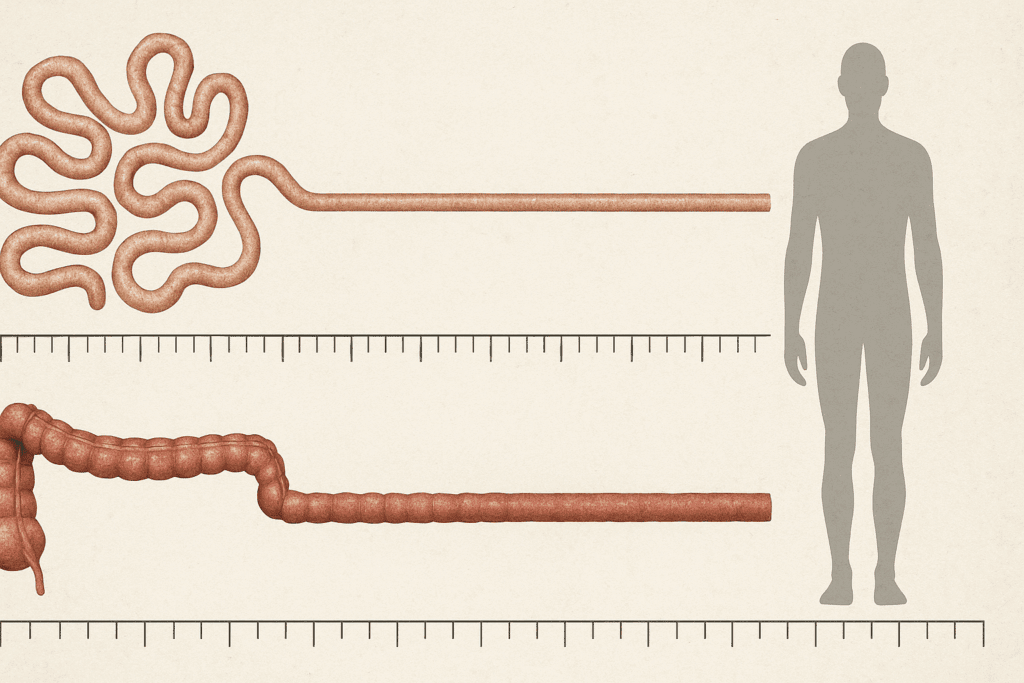
How Long Is the Human Intestinal Tract?
A common curiosity among those studying human anatomy is how long is the human intestinal tract. In total, the combined length of the small and large intestine in an adult is approximately 25 to 30 feet. The small intestine accounts for about 20 feet, while the large intestine is about five feet long. This extensive length is necessary for ensuring that nutrients and water have sufficient time and surface area to be effectively absorbed.
What makes this even more impressive is how this massive system is compacted efficiently within the abdominal cavity. The coiling and folding of the intestines maximize efficiency without compromising space for other vital organs. This spatial arrangement also underscores why abdominal surgeries, imaging, and diagnoses require a clear understanding of the parts of intestine and their respective locations. Knowing where are your intestines allows for more precise interventions, whether surgical or dietary.
Frequently Asked Questions: Understanding the Intestines
1. How does stress impact the lower intestine and overall intestinal function? Stress can significantly affect the lower intestine and the entire intestinal tract by altering motility, enzyme secretion, and the gut-brain axis. Chronic psychological stress is known to change how the intestine intestine functions by increasing inflammation and disrupting the microbiota in both the large gut and the small bowel. The lower intestine, which includes the sigmoid colon and rectum, is especially sensitive to hormonal and neurological changes during stress, often resulting in symptoms like constipation or urgency. Modern neurogastroenterology studies show that irritable bowel syndrome (IBS), commonly affecting the large and small bowel, often has a strong stress component. Recognizing where are your intestines located in relation to stress-sensitive nerve pathways can help patients and clinicians approach therapy with holistic strategies, such as gut-directed hypnotherapy or biofeedback.
2. Why do athletes sometimes experience intestinal discomfort during intense exercise? During high-intensity workouts, blood is redirected away from the digestive organs, which affects the parts of the small intestine and reduces their efficiency. This reduced blood flow can cause cramping, diarrhea, or nausea, especially in endurance sports. The small vs large intestine also responds differently: while the small bowel reacts with malabsorption, the large bowel can be prone to urgency and loose stools. Many athletes are unaware of where is your bowel most sensitive during exercise, which can lead to misinterpretation of symptoms. Proper hydration, electrolyte balance, and low-fiber pre-race meals can help stabilize the function of the small and large intestine during physical stress.
3. What role does sleep play in maintaining a healthy large gut and intestinal system? Sleep has a profound regulatory effect on the large gut, particularly in supporting peristalsis and microbial balance. Disruptions in circadian rhythms can negatively impact bowel parts, including segments of the lower intestine responsible for final waste processing. Research suggests that sleep deprivation alters the microbial ecosystem of the intestine intestine, especially within the large and small colon. Because bowel motility is influenced by sleep hormones like melatonin, poor sleep can contribute to irregularity in the large intestine function in digestive system balance. Understanding how deeply interconnected rest and gut health are can guide patients toward lifestyle changes that support long-term wellness in the large and small bowel.
4. How does aging affect the various parts of intestine functionally and anatomically? As individuals age, the structural integrity and motility of the intestine system undergo notable changes. The small and big intestine may experience a decline in muscle tone, leading to slower transit times and a higher likelihood of constipation. The large intestine parts such as the descending and sigmoid colon become more vulnerable to conditions like diverticulosis. Elderly patients may not always recognize where is feces stored due to nerve desensitization in the rectum, resulting in reduced sensation to defecate. Nutrient absorption in the parts of the small intestine may also decrease, especially for vitamins like B12 and calcium, which impacts overall health.
5. Are there anatomical variations in intestines anatomy that can affect digestion? Yes, anatomical differences in the intestines anatomy can lead to altered digestion or complications. Some individuals may be born with longer-than-average small and large intestine segments, which can predispose them to volvulus or slower digestion. Others may have a mobile cecum or an atypical location for where is your large intestine, affecting colonoscopy outcomes or appendicitis diagnosis. These variations can also influence how effectively food moves from the small and large intestine, disrupting the coordinated balance of absorption and elimination. Clinicians increasingly rely on imaging techniques and custom intestine system diagrams to map out these differences for surgical planning or chronic digestive disorders.
6. Can posture influence where is poop stored or how efficiently the body eliminates waste? Posture plays a surprisingly important role in intestinal efficiency, especially concerning where is poop stored in the lower bowel. Poor posture can kink segments of the large bowel and small bowel, particularly the rectosigmoid junction where feces pass into the rectum. Sitting in a more natural squatting position has been shown to improve elimination by straightening the angle between bowel parts and reducing strain. In many cultures where squatting toilets are common, rates of constipation and hemorrhoids are lower, suggesting a biomechanical advantage. Knowledge of where is your bowel positioned during defecation helps tailor ergonomic solutions for improved gut health.
7. How does diet impact the microbial environment across the small and large colon? Diet shapes the microbial landscape of the intestine intestine with immediate and long-term effects. Fermentable fibers (prebiotics) found in foods like oats, bananas, and garlic nourish beneficial bacteria particularly in the large intestine parts, where most fermentation occurs. However, excessive sugar and processed food consumption can harm microbial diversity and affect the balance between the small and big intestine. In some cases, undigested carbohydrates reaching the lower intestine are fermented excessively, leading to gas and bloating—a symptom often misattributed without knowledge of where are your intestines located and how fermentation varies between the small and large colon. A well-rounded diet supports homeostasis in the large gut, fostering resilience against pathogens and inflammation.
8. Why do some people experience pain in the lower abdomen if the problem originates in the upper small intestine? Referred pain is a phenomenon where discomfort is felt in an area distant from its actual origin, which can occur between different parts of the intestine intestine. Even though the upper small intestine lies higher in the abdomen, the nerves that transmit pain signals may converge with those serving the lower intestine, causing mislocalized sensations. This is why patients might feel pain near where is your large intestine despite the issue originating in the duodenum. Advanced gastrointestinal diagnostics increasingly use high-resolution manometry to trace the origin of pain based on mapped nerve pathways. A nuanced understanding of where are your intestines and their overlapping nerve networks is crucial for accurate diagnosis.
9. Can artificial intelligence enhance the interpretation of the intestine system diagram in diagnostics? Artificial intelligence (AI) is transforming how clinicians interpret the intestine system diagram by providing faster, more accurate image analyses. AI-enhanced colonoscopy tools now help detect polyps and abnormalities across the small and large bowel with greater precision. These technologies can also model the flow of content through the big intestine and small intestine in simulated 3D environments, offering predictive insights for disorders like Crohn’s disease. By recognizing subtle anomalies in the parts of intestine, AI tools offer personalized treatment options tailored to unique anatomical variations. As this technology evolves, it may become standard for identifying where is faeces stored dysfunctions and mapping out exact bowel parts involved in disease progression.
10. What are the long-term consequences of ignoring irregularities in the small vs large intestine? Overlooking persistent digestive symptoms can lead to chronic inflammation, malabsorption, or even structural damage within the large and small bowel. Recurrent bloating, irregular bowel movements, or unexplained fatigue may indicate deeper issues in the small and large intestine, such as leaky gut syndrome or early-stage inflammatory bowel disease. When left unmanaged, these conditions can affect not just where does poop come from or where is your small intestine active, but also systemic immunity and mental clarity. Knowing what happens in the small intestine and how it differs from the function of the lower intestine allows for earlier intervention and reduced disease burden. A proactive understanding of how long is the human intestinal tract in relation to symptom timing also supports better clinical outcomes.
Final Thoughts on Intestinal Structure and Function
In comprehending where are your intestines located, we uncover much more than just anatomical facts. We enter a world of intricate functions, subtle interactions, and life-sustaining processes that are easy to overlook. The small and large intestine are not just conduits for food—they are living, responsive systems that engage with every aspect of our nutrition and well-being. From the microscopic villi of the small intestine to the microbial metropolises of the large gut, each structure contributes something essential to the whole.
Understanding the anatomy of the small vs large intestine allows for a clearer grasp of where is your bowel, where is feces stored, and what happens in the small intestine as nutrients are extracted and waste is formed. With this knowledge, individuals are better equipped to care for their digestive health, recognize warning signs, and appreciate the remarkable journey that food takes through the body. Whether exploring the intestine system diagram or simply asking where does poop come from, the answers lie in the incredible design and coordinated function of the large and small bowel.
Ultimately, knowledge of the large intestine function in digestive system health is foundational to making informed choices about diet, wellness, and disease prevention. From the most basic queries about bowel parts to the deeper questions of intestinal integrity, every answer begins with a clear understanding of the intestines and their indispensable role in human life.
Further Reading:
Your Digestive System & How it Works


